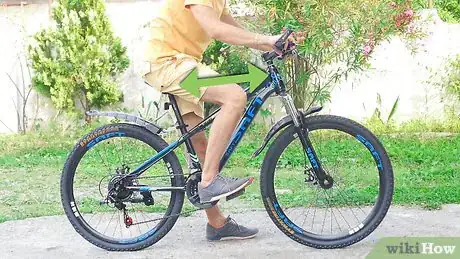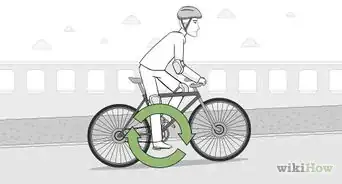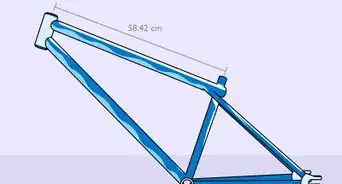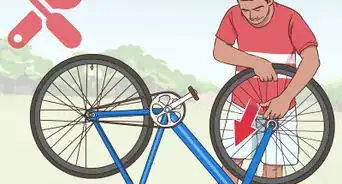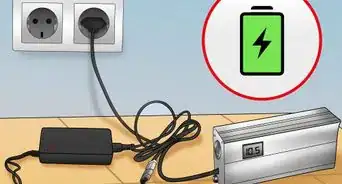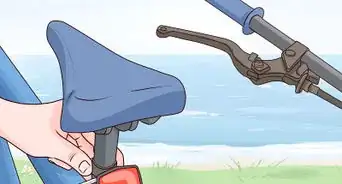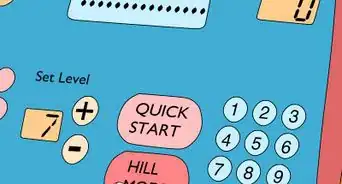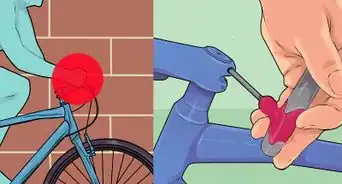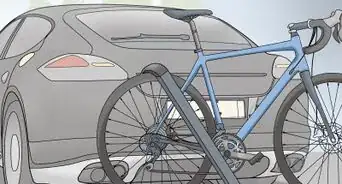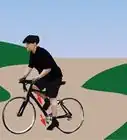This article was co-authored by Ikaika Cox. Ikaika Cox is the Shop Director at the Salt Lake City branch Bicycle Collective in Salt Lake City, Utah. He has been a bike mechanic since 2012, beginning as a volunteer with the Provo Bicycle Collective, and growing and honing his skills as a bicycle mechanic and educator in multiple Bicycle Collective locations over the years. He now leads the Salt Lake City branch of the Bicycle Collective.
There are 8 references cited in this article, which can be found at the bottom of the page.
wikiHow marks an article as reader-approved once it receives enough positive feedback. This article has 12 testimonials from our readers, earning it our reader-approved status.
This article has been viewed 611,090 times.
Having your bike seat adjusted to the right height is essential for a comfortable ride, efficient pedaling, and avoiding injury. Luckily, adjusting your seat is easy on almost all bikes, and you can make simple adjustments to get everything just right.
Steps
Adjusting Seat Height
-
1Know that a seat at the correct height leads to comfortable, even pedal strokes. You know your seat is at the right height if you can keep your hips stable on the bike instead of rocking them back and forth to reach the bottom of the pedal stroke. When your foot is at the lowest point while pedaling, you want your knee to be slightly bent, not locked out completely straight or curved.
- Your knee should be bent roughly 25 degrees. This feels similar to standing upright in an athletic position—just a slight bend is enough.[1]
- If you do not have access to measuring tape, use this as your guideline for adjusting the seat height by hand: knee slightly bent, hips square while riding, and comfortable ability to pedal.
-
2Measure your pubic bone height. Get some adhesive tape, a metal measuring tape, and 2 paint sticks or rulers. Trap the end of the measuring tape between the paint sticks and tape them together. Plant your bare feet flat on the floor, 10 inches (25 cm) apart. Insert the paint sticks between your legs perpendicular to your hips and pull them straight up until you hit your pubic bone. Hold the sticks firmly in place, with one hand in front of your crotch and the other behind your rear. Have a friend pull the measuring tape down to the floor and measure the distance from your pubic bone to the floor.[2]
- For an accurate measurement, your friend should position the measuring tape midway between your feet. It may be helpful to mark off the 10 inches (25 cm) on the floor so that you can position your feet and the tape correctly.
- Measure at least 2-3 times to make sure you get an accurate reading.
- If you took the measurement in inches, convert it to centimeters. You can then calculate your saddle height by subtracting 10 to 10.5 centimeters from your pubic bone height. For example, if your PBH is 84 centimetres (33 in), your saddle height would be 73.5–74 centimetres (28.9–29.1 in).
- The saddle height measurement is from the bottom bracket (where the cranks attach to the frame of your bike) to the top of the saddle.
Advertisement -
3Learn how your seat post adjusts. Seat posts are loosened and adjusted at the junction where the seat post meets the bike frame. A quick-release lever at the base of the seat post can be pried opened and adjusted by hand. If there is a small bracket with a screw in it, you have a bolted seat post: use an Allen key or adjustable wrench to loosen the bolt just enough to move the seat post.
-
4Adjust the seat height to your measured length. Gently slide the seat post up or down to reach your ideal measurement. It can help to nick the post at the right height, so you can find this adjustment again if the seat slips or someone borrows the bike.
-
5Tighten the seat firmly. Either press the quick-release lever back down to its locked position, or re-tighten the bolts with your Allen key or adjustable wrench until there is no movement. You do not need to get it so tight that you can't undo it later. Basic hand tightness will be enough for many bikes.
- If you're not sure how much to tighten the seat, check your owner's manual or the manufacturer's website for torque specifications. This is especially important if your bike has a carbon fiber seatpost or frame.
-
6Check your measurement on a test ride. Head out into the driveway and go for a slow test ride. Make sure you can easily reach the pedals and get onto the bike, and your knees are not locked. Try standing while you pedal to make sure you can comfortably get out of the saddle. Make sure that the seat is facing straight ahead or your riding position will be awkward and uncomfortable.
- Place the ball of your foot on the pedal when you ride. There should now be a slight bend (25 degrees) in your knee when the pedal is at its lowest point. This is your optimal seat height.
- If you have clip pedals or cages, make sure you use them on your test ride—they will affect your ride.
- Everyone has a different body type—your pubic bone height measurement should be used as a starting point. You should then adjust the bike to fit you comfortably.[3]
-
7Troubleshoot any issues by moving the seat slightly up or down. If you have knee pain, the biggest cause is usually your seat height. Depending on where the pain is, you likely have different problems. However, if the pain does not go away with seat adjustments, you should see a doctor.
- If the pain is on the back of your knee, the seat is too high.
- If the pain is on the front of your knee, the seat is too low.[4]
- Your hips should be sturdy, not rocking, while you pedal. If you slide your hips to each side with your pedal strokes, your seat is too high.
Adjusting Seat Placement
-
1Know that the angle and forward position of a bike seat will affect your riding comfort. The height of your seat isn't the only thing that matters. Seats can be slid forward and backward and angled up or down to get rid of sore spots and make a more comfortable ride. To test for the perfect fore/aft position of the seat:
- While riding, stop your feet so that one pedal is at the 3:00 position (completely forward). Your foot should be flat.
- Imagine a straight line coming down from the front of your knee to the ground.
- This line should intersect through the middle of your pedal. In other words, your knee should be right over your pedal when in the 3:00 position.[5]
-
2Loosen the bolt underneath the seat to change forward/backward seat position. On the back of the seat, pointing down at the back wheel, is a small bolt that controls the seat placement. It connects to a bracket that clamps onto small metal tubes that hold the seat in place. Loosen this bolt by turning it counter-clockwise to lower the pressure on the clamps that keep the seat in place.
-
3Make sure the seat is far enough forward for a comfortable ride. You should be able to comfortably reach your handlebars, and your knee should be over the pedal when your foot is at 3:00 in the pedal rotation. A good test is to try standing as you ride. If your seat is in the right position, you should be able to stand up easily without pulling or pushing on the handlebars. If you experience any of the following problems, slide the seat forward or back while the bolt is still loose:
- Trouble standing or reaching for the bars and finger numbness can mean the seat is too far back.
- Shoulder pain and trouble feeling comfortable going down hills can mean your seat is too far forward.[6]
-
4Make sure that your seat angle is level with the floor. Use a carpenter's level to make sure the seat is flat—this evenly distributes your weight for more comfortable riding. That said, if you experience discomfort in your crotch you can adjust the seat a little, though no more than 3 degrees in either direction.
- Women should typically tilt the seat slightly down for more comfort.
- Men should typically tilt the seat slightly up for more comfort.[7]
-
5Loosen the bolts on the side of the seat to change the seat angle. This bolt, usually on the right of the seat, allows you to easily change the angle of the seat and then tighten it in place again. Some older seats have 2 small bolts underneath the seat, one in front of the seat post and one behind, that are needed to change the seat angle. You must tighten one side to push that side up while loosening the other, almost like a see-saw.[8]
- Never make large adjustments to your seat angle. Check your seat height and forward position first, then adjust the angle slightly, if at all.
-
6Visit a bike shop if you'd prefer a professional seat fitting. If you're having trouble getting your seat height and angle adjusted correctly, go to your local bike shop and ask if they have a fit studio. They can help you adjust your seat more precisely so that you get a safe and comfortable fit.
- Some fitting studios have sophisticated technology that can detect pressure points between your body and the saddle, allowing for extremely precise adjustments.
Expert Q&A
-
QuestionWouldn't those calculations make the seat too high to get onto?
 Ikaika CoxIkaika Cox is the Shop Director at the Salt Lake City branch Bicycle Collective in Salt Lake City, Utah. He has been a bike mechanic since 2012, beginning as a volunteer with the Provo Bicycle Collective, and growing and honing his skills as a bicycle mechanic and educator in multiple Bicycle Collective locations over the years. He now leads the Salt Lake City branch of the Bicycle Collective.
Ikaika CoxIkaika Cox is the Shop Director at the Salt Lake City branch Bicycle Collective in Salt Lake City, Utah. He has been a bike mechanic since 2012, beginning as a volunteer with the Provo Bicycle Collective, and growing and honing his skills as a bicycle mechanic and educator in multiple Bicycle Collective locations over the years. He now leads the Salt Lake City branch of the Bicycle Collective.
Bicycle Mechanic Typically, a correct saddle height will inhibit one’s ability to comfortably put a foot down while on the saddle. Correct saddle height will usually require the rider to come forward off the saddle to stand comfortably over the top tube when stopped, and the rider can mount the saddle again after starting again. Correct saddle height is about achieving the best biomechanical advantage while riding, not the most comfort while stopped.
Typically, a correct saddle height will inhibit one’s ability to comfortably put a foot down while on the saddle. Correct saddle height will usually require the rider to come forward off the saddle to stand comfortably over the top tube when stopped, and the rider can mount the saddle again after starting again. Correct saddle height is about achieving the best biomechanical advantage while riding, not the most comfort while stopped. -
QuestionWhen I ride, I don't feel the force of riding in my legs rather, I feel pain at my right lower back region. Please, what could possibly be wrong?
 Ikaika CoxIkaika Cox is the Shop Director at the Salt Lake City branch Bicycle Collective in Salt Lake City, Utah. He has been a bike mechanic since 2012, beginning as a volunteer with the Provo Bicycle Collective, and growing and honing his skills as a bicycle mechanic and educator in multiple Bicycle Collective locations over the years. He now leads the Salt Lake City branch of the Bicycle Collective.
Ikaika CoxIkaika Cox is the Shop Director at the Salt Lake City branch Bicycle Collective in Salt Lake City, Utah. He has been a bike mechanic since 2012, beginning as a volunteer with the Provo Bicycle Collective, and growing and honing his skills as a bicycle mechanic and educator in multiple Bicycle Collective locations over the years. He now leads the Salt Lake City branch of the Bicycle Collective.
Bicycle Mechanic It could be that your handlebars are too far away from the saddle, or too low relative to the saddle, causing your body to be too bent over. Try adjusting or switching your stem. If soreness persists, visit a bike fit professional or seek the advice of a medical professional.
It could be that your handlebars are too far away from the saddle, or too low relative to the saddle, causing your body to be too bent over. Try adjusting or switching your stem. If soreness persists, visit a bike fit professional or seek the advice of a medical professional. -
QuestionWhy might I be feeling soreness in my left hip?
 Ikaika CoxIkaika Cox is the Shop Director at the Salt Lake City branch Bicycle Collective in Salt Lake City, Utah. He has been a bike mechanic since 2012, beginning as a volunteer with the Provo Bicycle Collective, and growing and honing his skills as a bicycle mechanic and educator in multiple Bicycle Collective locations over the years. He now leads the Salt Lake City branch of the Bicycle Collective.
Ikaika CoxIkaika Cox is the Shop Director at the Salt Lake City branch Bicycle Collective in Salt Lake City, Utah. He has been a bike mechanic since 2012, beginning as a volunteer with the Provo Bicycle Collective, and growing and honing his skills as a bicycle mechanic and educator in multiple Bicycle Collective locations over the years. He now leads the Salt Lake City branch of the Bicycle Collective.
Bicycle Mechanic Most people’s legs are uneven lengths. Try adjusting your saddle height using your left leg as a reference. If that doesn’t help, adjust your foot position. Try pointing your toes slightly inward or outward while you pedal. If soreness persists, consult a bike fit professional, or seek the advice of a medical professional.
Most people’s legs are uneven lengths. Try adjusting your saddle height using your left leg as a reference. If that doesn’t help, adjust your foot position. Try pointing your toes slightly inward or outward while you pedal. If soreness persists, consult a bike fit professional, or seek the advice of a medical professional.
Warnings
- Always inspect your bike before you ride it.⧼thumbs_response⧽
- Riding an ill-fitting bicycle puts you at risk of repetitive-stress injuries.⧼thumbs_response⧽
- Do not raise your seat above the warning line printed on the seat post.⧼thumbs_response⧽
Things You'll Need
- A set of Allen keys
References
- ↑ http://www.bicycling.com/maintenance/bike-fit/how-adjust-your-saddle
- ↑ https://www.youtube.com/watch?v=7yxZkHpAB4g
- ↑ http://www.bicycling.com/maintenance/bike-fit/bike-fit-set-your-saddle-height
- ↑ http://www.ilovebicycling.com/knee-pain-cycling-causes-solutions/
- ↑ http://www.bicycling.com/maintenance/bike-fit/bike-fit-set-your-saddle-height
- ↑ http://www.utahmountainbiking.com/fix/seat.htm
- ↑ http://www.jimlangley.net/crank/bikefit.html
- ↑ http://www.utahmountainbiking.com/fix/seat.htm
- Videos provided by Global Mountain Bike Network
About This Article
To adjust your bike seat's height, look for a quick-release lever at the base of the seat, pry it open, and adjust it higher or lower as needed. For bolted seats, use an Allen key or wrench to loosen the bolt and then adjust the height up or down. If you need to adjust the seat forward or backward, loosen the bolt underneath, then move the seat into the desired position and tighten the bolt. To change the angle, loosen the bolts on the side, adjust, then tighten the bolts firmly in place again. To learn more from our Bike Mechanic co-author, like the correct positioning for your bike seat, keep reading the article!


